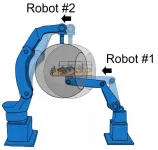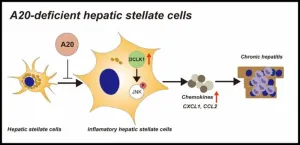(Press-News.org) August 29, 2024 — A machine learning algorithm performs well in predicting the risk of persistent opioid use after hand surgery, reports a study in the August issue of Plastic and Reconstructive Surgery®, the official medical journal of the American Society of Plastic Surgeons (ASPS). The journal is published in the Lippincott portfolio by Wolters Kluwer.
"We found that a machine learning model performs well in identifying hand surgery patients who are more likely to become persistent opioid users," comments ASPS Member Surgeon Kevin C. Chung, MD, MS, of University of Michigan, Ann Arbor. "This may provide a more efficient strategy to identify high-risk patients and implement measures to prevent opioid addiction. Similarly, the use of artificial intelligence can facilitate a more personalized approach in prescribing the right pain medication in the optimal amount for a specific patient undergoing a particular operation."
Two machine learning models tested to predict persistent opioid use
The study evaluated two previously described machine learning models: one using patient-reported data from the Michigan Genomics Initiative (MGI) and one based on insurance claims data. The models were first evaluated in a large sample of general surgery patients, then in patients undergoing hand surgery, such as carpal tunnel or wrist fracture surgery.
The study focused on whether the machine learning models could predict which patients would develop persistent opioid use, based on prescriptions filled up to six months after surgery. The MGI model included 889 patients, about half of whom had previous opioid use. The claims model was limited to 439 "opioid-naive" patients, without recent opioid use.
In the MGI model, which included previous opioid users, 21% of patients developed persistent opioid use. In the insurance claims model, which excluded previous opioid users, 10% of patients had persistent opioid use.
On "area under the curve" analysis, the MGI model performed very well in identifying patients with persistent opioid use: 84% in the model trained on hand surgery data and 85% in the general surgery population. By contrast, in the claims model, predictive ability was 69% based on hand surgery data and only 52% in the full data set.
Machine learning may streamline assessment of postoperative opioid risk
In the MGI model, having an opioid prescription before surgery was the strongest predictor of postoperative opioid use. Other predictive factors included overall body pain and prescription of hydrocodone – a relatively potent opioid that is commonly prescribed for postoperative pain.
As in other types of surgery, persistent opioid use is a risk for patients undergoing hand surgery. Although some risk factors have been identified, assessing postoperative opioid risk is a challenging and time-consuming process given the diversity of the patient population and variation in complexity of procedures. The new study suggests that machine learning can provide a more integrated, straightforward approach to identifying high-risk patients.
Models including patient-reported data on factors like pain and mental health – such as that collected in the MGI – appear to offer the highest predictive value. "With access to comprehensive datasets, machine learning has the potential to streamline the identification and analysis of detailed factors that influence patients’ postoperative pain experiences," the researchers write.
The authors note some limitations of their study, which may not reflect changes in prescribing patterns in response to the opioid epidemic. Dr. Chung and coauthors conclude: "In practice, these models could be implemented as decision-support tools to help clinicians efficiently identify patients who are most vulnerable to addiction and in need of tailored pain management or counseling."
Read Article: Predicting Persistent Opioid Use after Hand Surgery: A Machine Learning Approach
Wolters Kluwer provides trusted clinical technology and evidence-based solutions that engage clinicians, patients, researchers and students in effective decision-making and outcomes across healthcare. We support clinical effectiveness, learning and research, clinical surveillance and compliance, as well as data solutions. For more information about our solutions, visit https://www.wolterskluwer.com/en/health.
###
About Wolters Kluwer
Wolters Kluwer (EURONEXT: WKL) is a global leader in information, software solutions and services for professionals in healthcare; tax and accounting; financial and corporate compliance; legal and regulatory; corporate performance and ESG. We help our customers make critical decisions every day by providing expert solutions that combine deep domain knowledge with technology and services.
Wolters Kluwer reported 2023 annual revenues of €5.6 billion. The group serves customers in over 180 countries, maintains operations in over 40 countries, and employs approximately 21,400 people worldwide. The company is headquartered in Alphen aan den Rijn, the Netherlands.
For more information, visit www.wolterskluwer.com, follow us on LinkedIn, Facebook, YouTube and Instagram.
END
Machine learning predicts which patients will continue taking opioids after hand surgery
Artificial intelligence tool may help to prevent addiction, reports Plastic and Reconstructive Surgery®
2024-08-29
ELSE PRESS RELEASES FROM THIS DATE:
$15.5 million NIH award funds development of national network to include nursing home residents in clinical trials
2024-08-29
INDIANAPOLIS – A team led by research scientists from the Indiana University School of Medicine and Regenstrief Institute has received funding expected to total $15.5 million from the National Institutes of Health’s National Institute on Aging to establish a national network structure to include more nursing home residents in clinical trials.
Even though clinical trials are critical to the development and testing of medical therapies and treatments including drugs and care models, individuals living in nursing homes are rarely included in clinical research studies.
The new five-year award will fund ...
What’s in the microbiome of the foods we eat?
2024-08-29
Microbes are part of the food we eat and can influence our own microbiome, but we know very little about the microbes in our foods. Now, researchers have developed a database of the “food microbiome” by sequencing the metagenomes of 2,533 different foods. They identified 10,899 food-associated microbes, half of which were previously unknown species, and showed that food-associated microbes account for around 3% of the adult and 56% of the infant gut microbiome on average. The study published August 29 in the journal ...
Scientists discover how starfish get ‘legless’
2024-08-29
Researchers at Queen Mary University of London have made a groundbreaking discovery about how starfish manage to survive predatory attacks by shedding their own limbs. The team has identified a neurohormone responsible for triggering this remarkable feat of self-preservation.
Autotomy, the ability of an animal to detach a body part to evade predators, is a well-known survival strategy in the animal kingdom. While lizards shedding their tails are a familiar example, the mechanisms behind this process remain largely mysterious.
Now, scientists have unveiled a key piece of the puzzle. By studying the common European starfish, ...
Hormone therapy and biological aging in postmenopausal women
2024-08-29
About The Study: Postmenopausal women with historical hormone therapy (HT) use were biologically younger than those not receiving HT, with a more evident association observed in those with low socioeconomic status. The biological aging discrepancy mediated the association between HT and decreased mortality. Promoting HT in postmenopausal women could be important for healthy aging.
Corresponding Author: To contact the corresponding author, Chenglong Li, PhD, email chenglongli@bjmu.edu.cn.
To access the embargoed study: Visit our For The Media website at this link https://media.jamanetwork.com/
(doi:10.1001/jamanetworkopen.2024.30839)
Editor’s ...
Persistent neighborhood poverty and breast cancer outcomes
2024-08-29
About The Study: The findings of this study of women ages 18 or older diagnosed with stage I to III breast cancer between 2010 and 2018 suggest that residing in persistently impoverished neighborhoods is associated with poor tumor characteristics and increased mortality.
Corresponding Author: To contact the corresponding author, Samilia Obeng-Gyasi, MD, MPH, email samilia.obeng-gyasi@osumc.edu.
To access the embargoed study: Visit our For The Media website at this link https://media.jamanetwork.com/
(doi:10.1001/jamanetworkopen.2024.27755)
Editor’s Note: Please see the article for additional information, including other authors, ...
Greenhouse gas emissions and costs of inhaler devices in the US
2024-08-29
About The Study: Inhaler prescriptions filled by Centers for Medicare & Medicaid Services beneficiaries in 2022 resulted in an estimated 1.15 million metric tons of carbon dioxide equivalent emissions, equivalent to 226,960 homes’ yearly electricity use. Metered-dose inhalers were responsible for nearly all inhaler-related emissions, with the largest contribution arising from short-acting β-agonist medications. Although dry-powder and soft-mist inhalers had substantially lower emissions, they accounted for a disproportionate amount of spending, representing nearly two-thirds ...
Novel motion simulator reveals key role of air flow in rodent navigation
2024-08-29
How are rodents able to navigate pitch-black subway tunnels or other dark environments so adeptly, despite not being able to rely on vision?
With the assistance of a novel motion simulator, researchers at Bar-Ilan University in Israel have discovered that rats rely on airflow to navigate their surroundings. When they move, the flow of air relative to their bodies provides crucial information, complementary to their sense of balance, to perceive their own motion in space. This might explain their agility in the dark as they scurry through pipes and tunnels, ...
Combo immunotherapy produces distinct waves of cancer-fighting T cells with each dose
2024-08-29
PHILADELPHIA – A new tool for monitoring immune health patterns over time has revealed how a pair of checkpoint inhibitor therapies works together to recruit new cancer-fighting T cells with every infusion. Findings from the use of the new tool, developed by researchers at the University of Pennsylvania Perelman School of Medicine and Penn Medicine’s Abramson Cancer Center (ACC), were published today in Cancer Cell. The study challenges fundamental assumptions about how a common immunotherapy ...
Finding new targets for blocking chronic hepatitis
2024-08-29
Researchers from Tokyo Medical and Dental University (TMDU) determine how a protein called A20 can regulate the inflammatory response to suppress chronic hepatitis
Tokyo, Japan – Many individuals worldwide suffer from chronic liver disease (CLD), which poses significant concerns for its tendency to lead to hepatocellular carcinoma or liver failure. CLD is characterized by inflammation and fibrosis. Certain liver cells, called hepatic stellate cells (HSCs), contribute to both these characteristics, but how they are specifically involved in the inflammatory response is not ...
New Microbiology Society Publish and Read consortium deal now available to science institutions and hospitals across Germany
2024-08-29
The Microbiology Society, one of the largest microbiology societies in Europe, is pleased to announce a new three year Publish and Read offering with German consortium ZB Med – Information Centre for Life Sciences, available to its 400 member institutions and 2,000 hospitals. This agreement was established in partnership with HARRASSOWITZ, the Society’s representative agency in Germany.
From 2025, member institutions can join this consortium-wide Publish and Read agreement to enjoy discounted pricing. For participating institutions, the ...
LAST 30 PRESS RELEASES:
University of Oklahoma researcher awarded funding to pursue AI-powered material design
Exploring how the visual system recovers following injury
Support for parents with infants at pediatric check-ups leads to better reading and math skills in elementary school
Kids’ behavioral health is a growing share of family health costs
Day & night: Cancer disrupts the brain’s natural rhythm
COVID-19 vaccination significantly reduces risk to pregnant women and baby
The role of vaccination in maternal and perinatal outcomes associated with COVID-19 in pregnancy
Mayo Clinic smartwatch system helps parents shorten and defuse children's severe tantrums early
Behavioral health spending spikes to 40% of all children’s health expenditures, nearly doubling in a decade
Digital cognitive behavioral treatment for generalized anxiety disorder
Expenditures for pediatric behavioral health care over time and estimated family financial burden
Air conditioning in nursing homes and mortality during extreme heat
The Alps to lose a record number of glaciers in the next decade
What makes a good proton conductor?
New science reporting guide published for journalists in Bulgaria
New international study reveals major survival gaps among children with cancer
New science reporting guide published for journalists in Turkey
Scientists develop a smarter mRNA therapy that knows which cells to target
Neuroanatomy-informed brain–machine hybrid intelligence for robust acoustic target detection
Eight SwRI hydrogen projects funded by ENERGYWERX
The Lundquist Institute and its start-up company Vitalex Biosciences Announces Strategic Advancement of Second-Generation fungal Vaccine VXV-01 through Phase 1 Trials under $40 Million Competitive Con
Fine particles in pollution are associated with early signs of autoimmune disease
Review article | Towards a Global Ground-Based Earth Observatory (GGBEO): Leveraging existing systems and networks
Penn and UMich create world’s smallest programmable, autonomous robots
Cleveland researchers launch first major study to address ‘hidden performance killer’ in athletes
To connect across politics, try saying what you oppose
Modulating key interaction prevents virus from entering cells
Project explores barriers to NHS career progression facing international medical graduates
Jeonbuk National University researchers explore the impact of different seasonings on the flavor perception of Doenjang soup
Two Keck Medicine of USC Hospitals named Leapfrog Top Teaching Hospitals
[Press-News.org] Machine learning predicts which patients will continue taking opioids after hand surgeryArtificial intelligence tool may help to prevent addiction, reports Plastic and Reconstructive Surgery®



